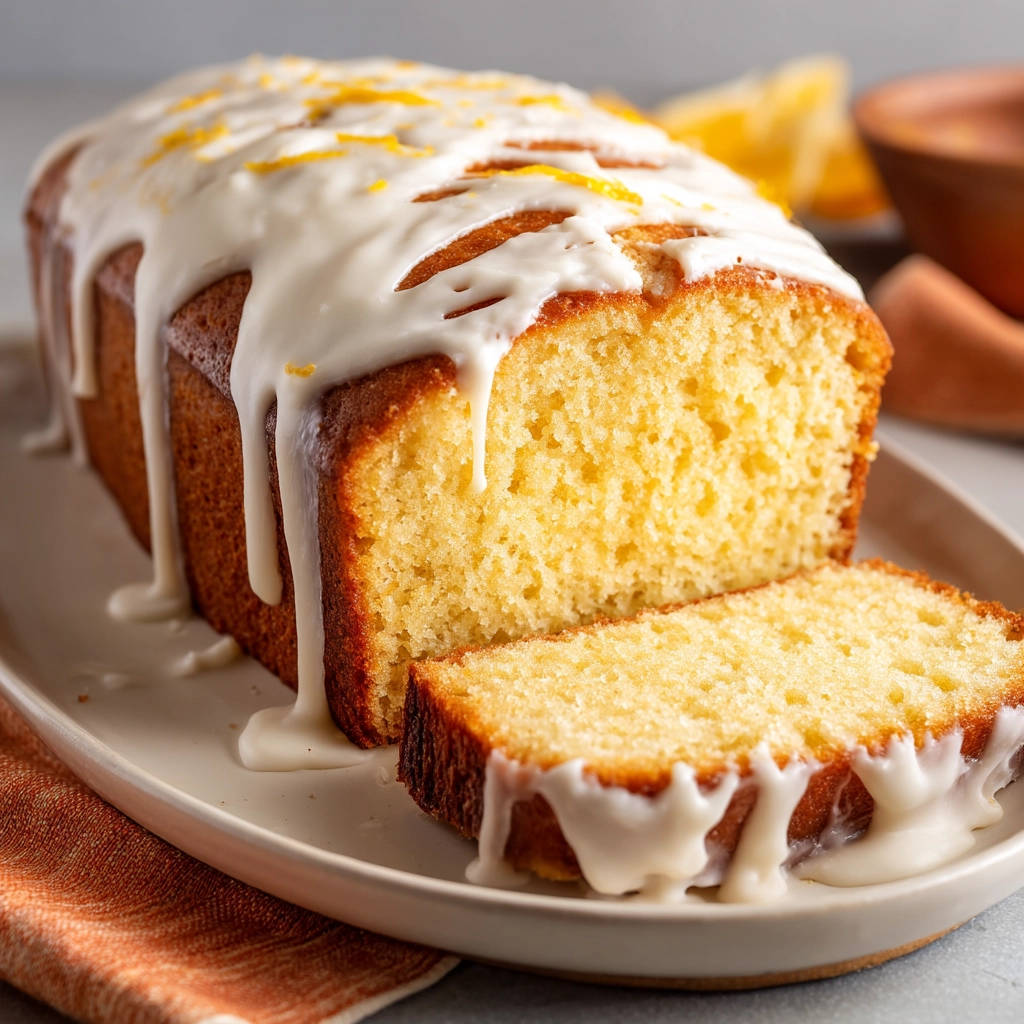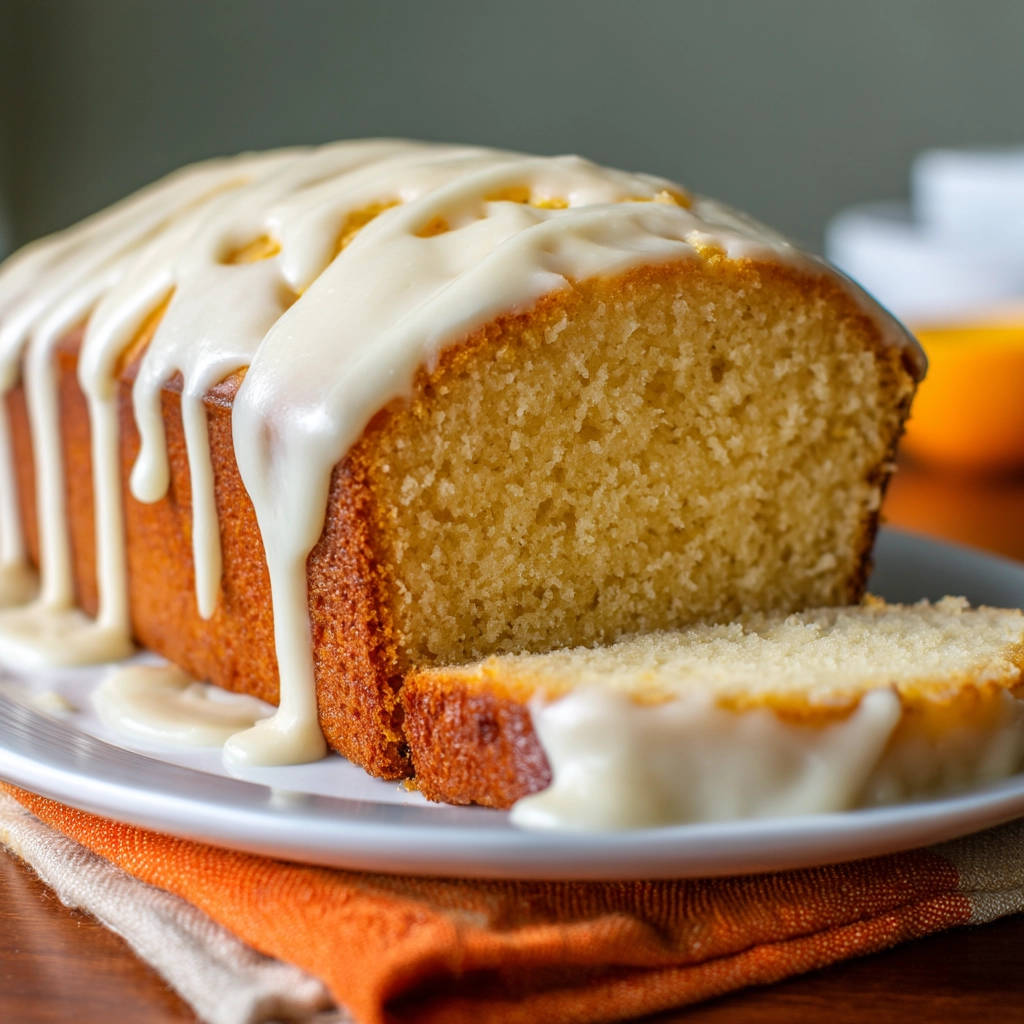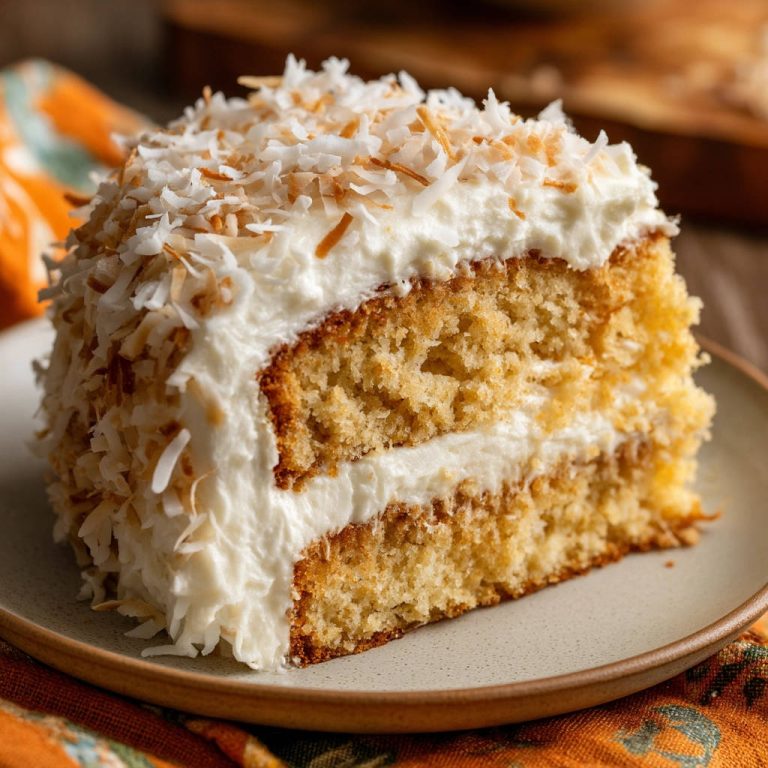Is there anything more disappointing than a dry, crumbly loaf cake? I used to think it was inevitable, just part of the quick bread baking experience. But I discovered a simple trick that transforms ordinary lemon loaves into incredibly moist and tender delights. This Lemon Glazed Loaf recipe is easy to follow, and the results are guaranteed to impress. Get ready for a burst of bright citrus flavor in every bite!
Why You’ll Love This Lemon Glazed Loaf
This isn’t just another lemon loaf recipe; it’s a game-changer! Here’s why you’ll be making this one again and again:
- Unbelievably Moist: The lemon soak is the secret weapon, infusing the loaf with moisture and intense lemon flavor.
- Perfectly Balanced Sweetness: The combination of granulated sugar in the cake and powdered sugar in the glaze creates a harmonious sweetness.
- Zesty and Refreshing: The fresh lemon juice and zest deliver a vibrant citrus punch that’s perfect for any time of day.
- Easy to Make: Even beginner bakers can achieve bakery-worthy results with this straightforward recipe.
- Beautiful Presentation: The glossy lemon glaze makes this loaf cake a showstopper.
Gathering Your Ingredients for Lemon Glazed Loaf
Before we dive into the baking process, let’s talk about the ingredients. The key to a truly exceptional lemon loaf lies in using high-quality ingredients and understanding their roles in the recipe. The combination of butter, lemon, flour, and sugar creates a delicious, unforgettable taste experience.
Here’s what you’ll need:
- For the Loaf:
- 1 and 1/2 cups all-purpose flour: This forms the structure of our loaf. For a slightly denser, more tender crumb, you could substitute up to 1/4 cup with cake flour. Just be sure not to overmix the batter!
- 1 teaspoon baking powder: Our leavening agent, providing the lift for a light and airy texture. Make sure yours is fresh for the best results.
- 1/4 teaspoon salt: Don’t skip the salt! It enhances the other flavors and balances the sweetness.
- 1/2 cup unsalted butter, softened: Using softened butter is crucial for creaming it properly with the sugar, creating air pockets that contribute to a tender crumb. Make sure it’s softened, not melted.
- 1 cup granulated sugar: Provides sweetness and moisture. The creaming process also helps to aerate the batter.
- 2 large eggs: Eggs bind the ingredients together, add richness, and contribute to the structure of the loaf. Use room-temperature eggs for easier incorporation.
- 1/2 cup sour cream or plain yogurt: This is another secret weapon for moisture! The acidity also helps to tenderize the gluten in the flour. If you want to elevate your loaf cake even more, check out our decadent chocolate-topped cream cake recipe, which takes moistness to a whole new level! Decadent Chocolate Topped Cream Cake Recipe
- 1/4 cup fresh lemon juice: The star of the show! Freshly squeezed juice is essential for the brightest, most vibrant flavor.
- Zest of 2 lemons: The lemon zest packs an even bigger punch of lemon flavor than the juice alone. Be sure to only zest the yellow part of the peel, avoiding the bitter white pith.
- For the Lemon Soak:
- 1/4 cup fresh lemon juice: More lemon love to saturate the loaf!
- 2 tablespoons granulated sugar: This dissolves into the lemon juice, creating a sweet and tangy syrup that infuses the cake.
- For the Glaze:
- 1 and 1/2 cups powdered sugar: Creates a smooth, glossy glaze. Sifting it beforehand will prevent lumps.
- 2 to 3 tablespoons fresh lemon juice: Adds that final touch of lemon zing and helps to thin the glaze to the perfect drizzling consistency.
Crafting Your Lemon Glazed Loaf: Step-by-Step
Ready to bake? Follow these step-by-step instructions to create a perfectly moist and delicious lemon loaf. Remember, the lemon soak is key to achieving that melt-in-your-mouth texture. Don’t skip it!
- Preheat and Prep: Start by preheating your oven to 350 degrees Fahrenheit (175 degrees Celsius). While the oven heats, grease and flour a 9×5 inch loaf pan. This will prevent the cake from sticking and ensure easy removal. A light coating of cooking spray followed by a dusting of flour works perfectly.
- Combine Dry Ingredients: In a medium bowl, whisk together the all-purpose flour, baking powder, and salt. Whisking is essential here to evenly distribute the baking powder and salt throughout the flour. This ensures a consistent rise and flavor.
- Cream Butter and Sugar: In a large bowl, cream together the softened butter and 1 cup of granulated sugar until light and fluffy. This is where an electric mixer comes in handy, but you can also do it by hand with a wooden spoon. The goal is to incorporate air into the mixture, which will contribute to a tender crumb. This may take 3-5 minutes.
- Incorporate Eggs: Beat in the eggs one at a time, mixing well after each addition. Adding the eggs one at a time ensures that they are fully incorporated into the batter. If you add them all at once, the batter may curdle.
- Add Wet Ingredients: Stir in the sour cream or yogurt, lemon juice, and lemon zest until just combined. Be careful not to overmix at this stage, as it can develop the gluten in the flour and result in a tough cake. We want a tender loaf, so gentle mixing is key.
- Combine Wet and Dry: Gradually add the dry ingredients to the wet ingredients, mixing on low speed or by hand until just combined. Again, do not overmix! Mix only until the flour disappears.
- Bake: Pour the batter into the prepared loaf pan and spread evenly. Bake for 50-60 minutes, or until a wooden skewer inserted into the center comes out clean. The baking time may vary depending on your oven, so start checking for doneness around 50 minutes.
- Prepare the Lemon Soak: While the cake is baking, prepare the lemon soak. In a small bowl, whisk together the 1/4 cup lemon juice and 2 tablespoons granulated sugar until the sugar dissolves. This is a quick and easy step that will make a big difference in the final result.
- Soak the Loaf: Remove the cake from the oven and immediately poke holes all over the top using the wooden skewer. Then, carefully pour or brush the lemon soak evenly over the warm cake, allowing it to sink in. The holes allow the lemon soak to penetrate deep into the cake, infusing it with moisture and flavor.
- Cool and Unmold: Let the cake cool in the pan for about 15-20 minutes before inverting it onto a wire rack to cool completely. This allows the cake to firm up slightly, making it easier to remove from the pan.
- Glaze: Once the cake is completely cool, prepare the glaze. In a small bowl, whisk together the powdered sugar and 2-3 tablespoons of lemon juice until smooth. Add more juice a teaspoon at a time if needed for desired consistency. The glaze should be thick enough to coat the cake but thin enough to drizzle.
- Drizzle and Set: Drizzle the glaze over the cooled loaf, allowing it to drip down the sides. Let the glaze set before slicing and serving. This will give the glaze a beautiful, glossy finish.
Tips for Perfect Lemon Glazed Loaf Every Time
Want to ensure your lemon loaf is a resounding success? Here are a few extra tips and tricks:
- Don’t Overmix: Overmixing develops the gluten in the flour, leading to a tough cake. Mix only until the ingredients are just combined.
- Use Room Temperature Ingredients: Room temperature butter and eggs emulsify better, creating a smoother batter and a more tender cake.
- Grease and Flour Thoroughly: This prevents the cake from sticking to the pan and ensures easy removal.
- Let it Cool Completely: Resist the urge to slice into the cake while it’s still warm. Cooling allows the cake to firm up and the flavors to meld together.
- Make it Gluten-Free: Substitute the all-purpose flour with a gluten-free blend for a gluten-free version of this recipe. Be sure to use a blend that contains xanthan gum for best results. You may also want to check out our golden cottage cheese fritters for more delicious gluten free options! Golden Cottage Cheese Fritters
What to Serve With Lemon Glazed Loaf
This lemon loaf is delicious on its own, but it also pairs well with a variety of accompaniments. Enjoy a slice with a cup of coffee or tea for a delightful afternoon treat. It’s also a perfect dessert after a light meal. For a savory pairing, consider serving it alongside a simple salad or some slow cooker cheesy potatoes. Slow Cooker Cheesy Potatoes
Your Lemon Glazed Loaf Questions Answered (FAQ)
Can I use bottled lemon juice?
While bottled lemon juice will work in a pinch, fresh lemon juice provides the best, most vibrant flavor. It’s definitely worth the extra effort to squeeze your own.
Can I freeze this lemon loaf?
Yes, you can! Wrap the cooled, unglazed loaf tightly in plastic wrap and then in foil. Freeze for up to 2 months. Thaw overnight in the refrigerator before glazing and serving.
My lemon loaf is browning too quickly. What should I do?
If your loaf is browning too quickly, tent it loosely with aluminum foil during the last 15-20 minutes of baking. This will help to prevent the top from burning.
Can I use Meyer lemons?
Absolutely! Meyer lemons have a sweeter, less acidic flavor than regular lemons, which would add a unique twist to the loaf. You may want to reduce the amount of granulated sugar slightly to compensate for the extra sweetness.
Enjoy Your Homemade Lemon Glazed Loaf!
There you have it! A simple, yet incredibly satisfying Lemon Glazed Loaf recipe that’s guaranteed to become a new favorite. The moist texture, bright citrus flavor, and beautiful glaze make this loaf cake a winner every time. So, grab your ingredients, preheat your oven, and get ready to bake a little sunshine! Don’t forget to leave a comment below and let me know how your lemon loaf turns out. Happy baking!








